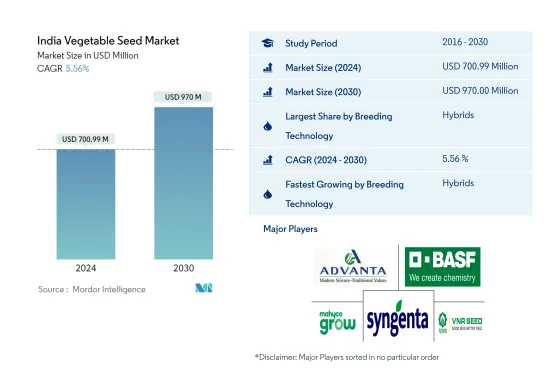Need help finding what you are looking for?
Contact Us
PUBLISHER: Mordor Intelligence | PRODUCT CODE: 1440502

PUBLISHER: Mordor Intelligence | PRODUCT CODE: 1440502
India Vegetable Seed - Market Share Analysis, Industry Trends & Statistics, Growth Forecasts (2024 - 2030)
PUBLISHED:
PAGES: 294 Pages
DELIVERY TIME: 2-3 business days
SELECT AN OPTION
The India Vegetable Seed Market size is estimated at USD 700.99 million in 2024, and is expected to reach USD 970 million by 2030, growing at a CAGR of 5.56% during the forecast period (2024-2030).

Key Highlights
- Cucurbits is the Largest Crop Family. The fastest growth is due to an increase in domestic consumption, short duration of cucurbit crops, and the availability of high-yielding varieties.
- Hybrids is the Largest Breeding Technology. There is an increase in the demand for hybrid seeds due to an increase in the cultivation area under hybrid seed and availbility of improved hybrid seed varieties.
- Roots & Bulbs is the Fastest-growing Crop Family. India is the leading producer of garlic, onion, and potatoes. The true seeds for garlic and potatoes were introduced leading the segment to be the fastest growing.
- Hybrids is the Fastest-growing Breeding Technology. The major companies are developing new hybrids and the adoption of hybrids is high due to disease-resistant, increased shelf life, high yield, and wider adaptability.
India Vegetable Seed Market Trends
Hybrids is the largest Breeding Technology
- India is the second-largest vegetable producer in the world after China. The production and average productivity of vegetables in India are far behind other countries due to the use of low-quality and low-yielding varieties.
- In India, hybrids and open-pollinated varieties and hybrid derivatives account for 68.7% and 31.3%, respectively, of the vegetable seed market due to an increase in the usage of hybrids in vegetable production.
- OPV seeds are more common in leafy vegetables, along with some roots and bulbs such as tapioca, yams, and sweet potato, as farmers are willing to produce them every year on some portion of the arable land for extra income. In this context, small-scale farmers use OPV seeds to save them for the next crop.
- Tomato, brinjal, okra, chili, and cucurbits are the major vegetables grown using hybrid seeds, and the varietal development in tomato and brinjal is high, with hybrid and OPVs being released from the public sector mostly in India.
- In India, the hybrid vegetable seed market and OPVs are growing at almost similar rates, i.e., 4.6% and 4.4% respectively, as farmers are preferring OPVs for their taste, shape, and size.
- The increasing population and decreasing arable land in India are boosting the demand for high-yielding varieties in hybrid or OPVs, along with disease and pest resistance, to decrease the input costs, as 80% of Indian farmers are small and marginal farmers.
- However, with the ongoing research trials in genetically modified vegetables, GM brinjal is expected to be released in the near future. Government policies on safe and high-yielding varieties are also expected to boost the growth of the hybrid vegetable seed market in India.
India Vegetable Seed Industry Overview
The India Vegetable Seed Market is fragmented, with the top five companies occupying 27.51%. The major players in this market are Advanta Seeds - UPL, BASF SE, Maharashtra Hybrid Seeds Co. (Mahyco), Syngenta Group and VNR Seeds (sorted alphabetically).
Additional Benefits:
- The market estimate (ME) sheet in Excel format
- 3 months of analyst support
Product Code: 92552
TABLE OF CONTENTS
1 EXECUTIVE SUMMARY & KEY FINDINGS
2 REPORT OFFERS
3 INTRODUCTION
- 3.1 Study Assumptions & Market Definition
- 3.2 Scope of the Study
- 3.3 Research Methodology
4 KEY INDUSTRY TRENDS
- 4.1 Area Under Cultivation
- 4.2 Most Popular Traits
- 4.3 Regulatory Framework
- 4.4 Value Chain & Distribution Channel Analysis
5 MARKET SEGMENTATION
- 5.1 Breeding Technology
- 5.1.1 Hybrids
- 5.1.2 Open Pollinated Varieties & Hybrid Derivatives
- 5.2 Cultivation Mechanism
- 5.2.1 Open Field
- 5.2.2 Protected Cultivation
- 5.3 Crop Family
- 5.3.1 Brassicas
- 5.3.1.1 Cabbage
- 5.3.1.2 Carrot
- 5.3.1.3 Cauliflower & Broccoli
- 5.3.1.4 Other Brassicas
- 5.3.2 Cucurbits
- 5.3.2.1 Cucumber & Gherkin
- 5.3.2.2 Pumpkin & Squash
- 5.3.2.3 Other Cucurbits
- 5.3.3 Roots & Bulbs
- 5.3.3.1 Garlic
- 5.3.3.2 Onion
- 5.3.3.3 Potato
- 5.3.3.4 Other Roots & Bulbs
- 5.3.4 Solanaceae
- 5.3.4.1 Chilli
- 5.3.4.2 Eggplant
- 5.3.4.3 Tomato
- 5.3.4.4 Other Solanaceae
- 5.3.5 Unclassified Vegetables
- 5.3.5.1 Asparagus
- 5.3.5.2 Lettuce
- 5.3.5.3 Okra
- 5.3.5.4 Peas
- 5.3.5.5 Spinach
- 5.3.5.6 Other Unclassified Vegetables
- 5.3.1 Brassicas
6 COMPETITIVE LANDSCAPE
- 6.1 Key Strategic Moves
- 6.2 Market Share Analysis
- 6.3 Company Landscape
- 6.4 Company Profiles
- 6.4.1 Advanta Seeds - UPL
- 6.4.2 BASF SE
- 6.4.3 Bayer AG
- 6.4.4 East-West Seed
- 6.4.5 Groupe Limagrain
- 6.4.6 Maharashtra Hybrid Seeds Co. (Mahyco)
- 6.4.7 Rijk Zwaan Zaadteelt en Zaadhandel B.V.
- 6.4.8 Sakata Seeds Corporation
- 6.4.9 Syngenta Group
- 6.4.10 VNR Seeds
7 KEY STRATEGIC QUESTIONS FOR SEEDS CEOS
8 APPENDIX
- 8.1 Global Overview
- 8.1.1 Overview
- 8.1.2 Porter's Five Forces Framework
- 8.1.3 Global Value Chain Analysis
- 8.1.4 Global Market Size and DROs
- 8.2 Sources & References
- 8.3 List of Tables & Figures
- 8.4 Primary Insights
- 8.5 Data Pack
- 8.6 Glossary of Terms
Have a question?


SELECT AN OPTION
Have a question?


Questions? Please give us a call or visit the contact form.
